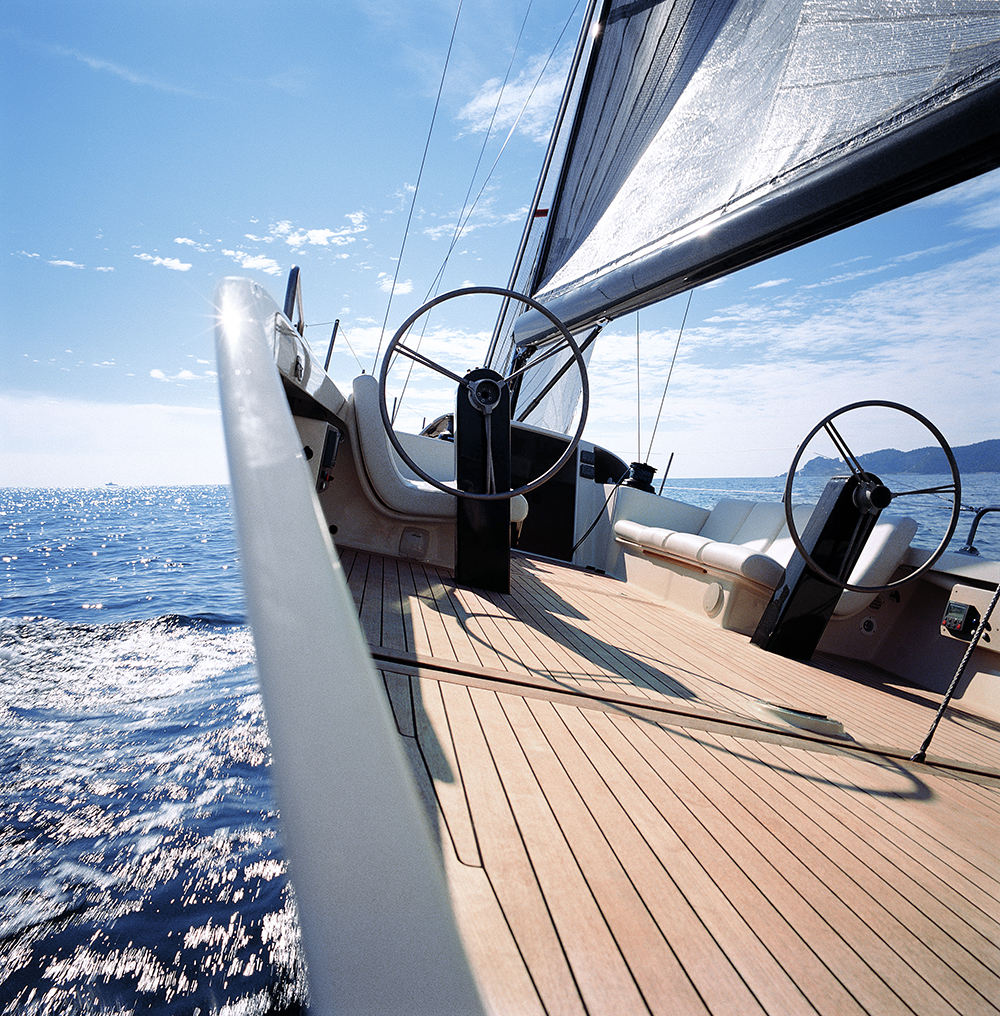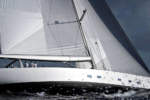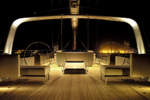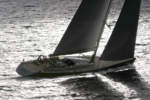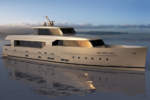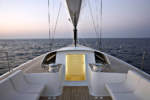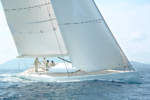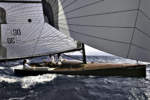Stella filante, 44 ft. Luca Brenta Yacht Design - photo by Guido Grugnola
Laura Andreini: In the sailing yachts sector the introduction of new technologies has led to a true revolution, both of the construction systems that have made it possible to build boats with ever higher performances, and of the ways we live and use the boats.
The decks of sailing boats used to be full of equipment for handling the sails; how has the external space of the boat been transformed today, and how has the comfort on board improved? Please tell me about your experience.
Lorenzo Argento: Our firm began to study the idea of hidden manoeuvres with the design of the first Wallygator. Luca Bassani gave us the possibility to make two boats, one of them a 100 feet in carbon, a boat that combines comfort and racer performances. To use a 100 feet boat, even with a professional crew, where the winch carries a sheet with a load of three or four tons, is very dangerous. Push-button sailing began with that boat about 20 years ago.
We have made others: the Wally B, with which our collaboration with Enrico Facino for the kitchen design began, and the Kenora. Then we have designed other boats, not just with Wally but also with Nautor’s Swan and private customers, above 80-90 feet; in 2005 we have begun this new project for B-yachts, and since then we have made about sixty, from the B30 to the B60, in various models and types.
Now we have only just finished a B42, owned by a very famous British architect, a boat of 42 feet. It is a matter of very complex boats in terms of design, because everything you cannot see is still there. Our research consists of making all the equipment disappear through new technical solutions.
Laura Andreini: Does your firm also design motor yachts, or only sailing yachts?
Lorenzo Argento: Our firm ranges from engine to sail, we are very flexible, what matters to us is to work on interesting projects. We have been working for some years with BSD Benetti Sail Division; its managing director is Simone Marconcini, former director of Nautor’s Swan, who has involved us in the design of a displacement motor yacht, with “quiet” lines, proportions and geometries.
Laura Andreini: Does your firm only employ architects, or also engineers who are able to design not only the upper-works but also the quick-works?
Lorenzo Argento: We are yacht designers, we have studied in Milan and in England, we are designers of sailing yachts by definition, and we therefore design the hull, the keel, the interiors, the layout, every part the boat is made of. As to motor boats, on the contrary, we avail ourselves of specialized engineers who develop the performance in terms of water resistance, also in the case of very slow displacement boats that travel at a cruise speed of 8-9, boats from 33 to 45 metres.
Laura Andreini: How much time does it take to build a B42?
Lorenzo Argento: 3,000 hours of work. It depends on how much time you dedicate to it and how many people you involve.
Laura Andreini: Has the fact that you have an architect as a customer made your work more complicated or has it simplified it?
Lorenzo Argento: The architect has not seen the boat yet. When he does, it will be a surprise. It was already quite defined on the outside and there wasn’t much to alter, but it has been changed a lot internally. Twenty days ago he decided to paint it RAL 9002 light grey, the same colour as a boat he has already had made. As to the graphic design of the name, there has been an incredible organization, it is called the “Dulcinea”.
The dinette area is very essential, there are two benches covered by cushions and two islands in Corian, one for the sink and one for the fridge, in addition to leather sacks made by a Roman saddle-maker, that cover two shelves.
All the structural elements have been left in view. The mast has a compression load of 6,000 kilos, the sheet of the mainsail starts from the stern, enters the boom, comes out of the boom, enters the mast, comes out of the mast, everything is computerized, all you have to do is push a button. Then there are the fastenings of the structural stays.
The materials used are carbon, epoxy resin, teak, few materials and a studied structural technology. The mast was made in Spain, the boom in Denmark. It has a 30-horse Volvo engine which can reach 8 knots, accessible from the interior or from the after peak.
Even if it is quite Spartan, the B42 costs about 400,000 euro, only the mast costs 40,000, while a boat of the same dimension as for instance a Beneteau costs about 150,000 euro.
Laura Andreini: Has your firm also worked with John Pawson?
Lorenzo Argento: We have made the B60 with him, it is a matter of an 18 metres with master cabin and bathroom in the bow, but he has performed a very different role, because in this case it has been the customer who has wanted us to involve John Pawson in the design of the interior; he has participated in the geometries of the boat according to his style. We have not cooperated to any great extent, not as we did with Piero Lissoni in another project.
Laura Andreini: On what basis do you develop a boat project?
Lorenzo Argento: Usually from a brief, from the request of a customer; the request is fundamental. There is a very intense relationship with the customer; we try to get inspiration from his personality, his habits, not to remain distant or neutral. In any case, also our language, the Italian style and our mastery of the technology is recognizable in every project.
Laura Andreini: How close is the relationship with tradition in present-day yacht design?
Lorenzo Argento: We have made presentations in which we have compared period yachts from the early Twentieth century, which did not have winches because nobody had invented them yet, they only had tackles. In this sense, we relate to tradition, but today we have the possibility to use new technologies that enable us to improve the performance of the boats, as the winch which makes it possible to pull the sheets without tackles.
Boats from the early years of last century had a very low profile; they were very elegant, with enormous masts, incredibly quick reaction and very deep keels.
Today, on the contrary, to keep the free board low, and as the keel is not as deep, we concentrate the weight in the ballast keels and build very light hulls.
What I don’t love is the copies, even if they are very fashionable in the yachting world. They are currently remaking the J class, 40 metres long boat with a low free board. It is a real replica in steel, the only difference is the material of the masts which are made in carbon.
It is like taking a Renaissance building and making it identical, even if with new materials.
We have recently built a yacht for a gallerist from New York, whom I met on a board of a Wally B, and that meeting has resulted in the Ghost, a sailing yacht of 122 feet. We have made a very innovative boat with great contents for him. It is difficult for a customer to accept the risks associated with building a new boat, making a prototype, because apart from the fact that it is more expensive, one cannot be certain that it is going to work. In fact, there are also examples of clamorous flops. It is much safer to do something the customer has already seen, with whose characteristics he is familiar.
Less sailing yachts than motor yachts are produced, and nine out of every ten of them are replicas.
Fifty out of sixty people who buy boats have no idea what a sailing yacht is, they are only fascinated by its image, it’s like buying Porsche and not knowing how to drive. SuperStar is a boat that navigates without wind, it is a unique project.
It is a new version of the Star Class, the most fascinating and well-known boat there is; it has 100 years of evolution behind it, it was originally a wooden boat but today it is built in carbon. The customer is someone who has used the Star a lot, and wanted a striking boat, a new version of the Star that was ten meters long rather than seven and a half. We have built a boat in carbon with sharp angles; it has required a year of design and a lot of research. It is a boat with a gigantic mainsail and a canting keel that moves 50 degrees. There are two pistons that act on the keel, while it is moved vertically by hand; it descends and clicks into place, and remains with two pivots inside the boat, that are connected to pistons that make it cant.
Laura Andreini: What professional figures are involved in the design of a boat?
Lorenzo Argento: The structural design is done by structural engineers. We give them the project and they provide us with dimensional data, reinforcement positions and the layers of carbon strips.
There is a continuous exchange of drawings between our firm and the structural engineers. For instance, to define the design of the longitudinal walls, the attachment of the fore shroud, the rudder axis, the keel system, the circular vang track, the fairlead, the canard, the lee-board.
Laura Andreini: Which are the best yacht building yards you work for?
Lorenzo Argento: For carbon, a material we use in 99% of the sailing yachts, we work all over the world, from New Zealand to Australia, from Italy to Finland to England.
Laura Andreini: Who do you consider to be the leading designers on an international level?
Lorenzo Argento: As far as sailing yachts are concerned, there are two clearly distinct worlds: that of racing yachts (America‘s Cup/TP52 and Volvo), and that of super cruisers. As to racers, Botin&Partners along with JuanK are the great leaders, while in the super cruiser category the firms of Dubois, Frers and Briand are the most prolific.
As to motor yachts, we may mention both Francesco Paszkowski and Luca Dini.
As a firm we are something in-between, we operate in both sectors (motor and sail) and our production has caught the attention of customers who love to explore new territories and who have, in the end, proven to be great innovators. Our great cruise sailing yachts also vaunt a high performance, while our motor boats are particularly quiet and safe.
One may hazard a comparison: the sailing yachts we produce are for sophisticated and expert sailors, while our motor yachts are for “fishermen” who are profound connoisseurs of the sea and its dangers, and they are therefore slow and very seaworthy boats.
Laura Andreini: Have the lines of your boats changed over the years, and if so, have they adapted to the evolution of the materials and new construction systems, or to fashions and preferences?
Lorenzo Argento: They follow either, to some extent; we have managed to reduce the weight of the materials and to concentrate the weight by using carbon. We put everything we save in the hull and the mast in the ballast, and this makes it possible to add more sail surface, we increase the sail carrying capacity and the rigidity of the hull.
Today large, powerful and stable boats are fashionable; the opposite of what we do or narrow, symmetric boats where weight provides stability, inspired by the trend of America’s Cup: when the boat heels it does not undergo any variations in terms of distribution of volume, it always remains very balanced. In a narrow boat where all the stability is in the ballast keel the guests can remain seated where they want to, something which is very important for their comfort. A wide boat is also called a Monomaran, it is more comfortable to make a crossing in it, but it is not as fun.
We like the theme of the low free board, the close contact with the water that you lose in large boats; we prefer to compromise on the interior space in order to be closer to the water.
Laura Andreini: How many projects do you manage to work on at the same time?
Lorenzo Argento: We are currently working on four projects. Proposals, sailing yachts, engine boats. Our firm does not work a lot with Italian customers, at present we are working first and foremost with Northern Europe and Spain.
We are working on a proposal for a 60 metres: there are three firms competing for the contract, and we must soon present the project to the owner. I draw a lot by hand; I make a sketch which I show to the customer. On this boat we will define they layout, and then there is usually a decorator who defines the interiors; on the Superstar, on the contrary, we have designed and defined every element.


